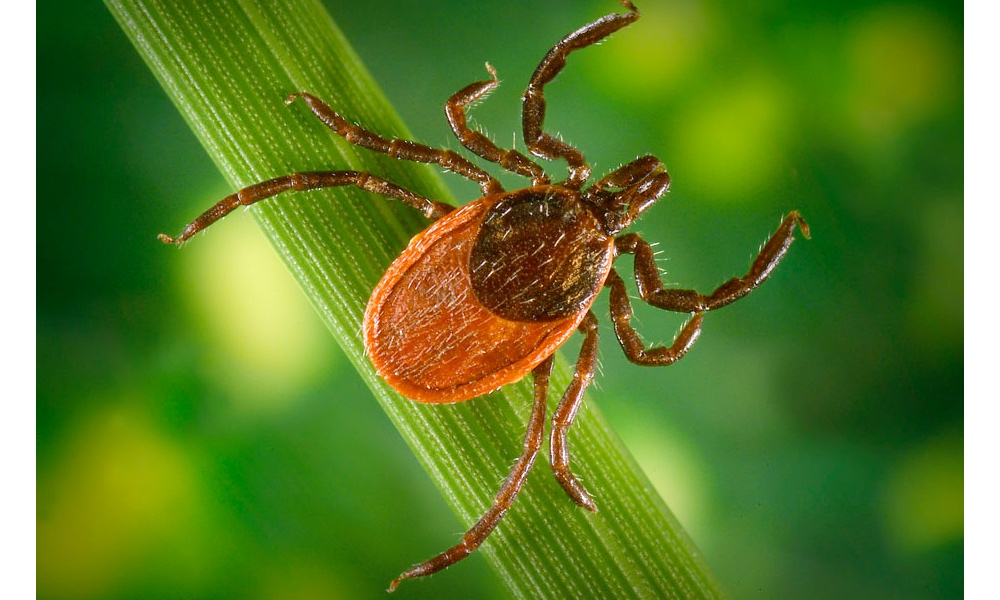Insurance records show that around 476,000 people are diagnosed and treated for Lyme Disease each year.
Lyme disease is caused by the bite of a tiny 8-legged insect called a tick. But not all ticks cause Lyme. The culprit is the Deer Tick — which can carry Borrelia burgdorferi, the bacterium that causes Lyme disease. Ticks also can carry other other tick-borne diseases.
Deer ticks are tough to see. The young “nymphs” are only the size of poppy seeds and adult deer ticks aren’t much larger — about the size of a sesame seed. If an infected deer tick chooses you for a bloody bite, you may get Lyme Disease.
Most cases of Lyme Disease can be cured with antibiotics, but it’s crucial to be diagnosed early and that means knowing its symptoms. Unfortunately, you can’t rely on a blood test since it takes several weeks to turn positive.When checking for ticks, pay special attention to the areas where ticks try to hide: under the arms, in and around the ears, inside the belly button, behind knees, between toes, under hair, around the groin and near the waist.
What should you look for?
According to The Tufts University Lyme Disease Initiative tick-borne diseases tend to share certain signs that may include:
- Fever
- Headache
- Muscle or joint pain
- Extreme fatigue
- An expanding red rash that sometimes resembles a bulls-eye
Not only are Lyme’s manifestations often perplexing, “Its effects are far-reaching,” Linden Hu, the Paul and Elaine Chervinsky co-director of the Tufts Lyme Disease Initiative and Professor of Immunology at Tufts School of Medicine, said in a press statement. “Our best strategy for tackling it is to prevent its occurrence, and the best way to do that is to get rid of its source.”
Until prevention becomes reality, Hu and Sam Telford II, professor of infectious disease and global health at Cummings School of Veterinary Medicine and Board Member of the Lyme Initiative, offer these safety tips for you and your family:
- Avoid tall grass and dense brush. Stay out of overgrown areas; when it’s possible stick to the middle of hiking trails. “Doing so will reduce the chances of a tick hopping on you for a ride,” Telford says.
- Dress for success: Wear light-colored clothing so you can easily spot a tick if it crawls on you. Also, wear long-sleeved shirts and long pants. Tuck your pants into socks and never wear open-toed shoes like sandals.
- Apply proven repellents. Use at least 20 percent DEET and follow the directions on the product. The CDC says DEET is safe for kids and infants who are older than 2 months. But avoid putting it on their hands and around the eyes. Consider spraying clothing, shoes and camping gear with insecticides that contain 0.5 percent permethrin. Carefully follow the directions on the label.
- Conduct regular tick checks. No matter how careful you may be, ticks can still bite you. So, make it a habit to check kids, pets and yourself every time you return indoors.
- According to Telford, the best thing to do is to take a shower and feel for new bumps on soapy skin. Plus, showers can wash away ticks before they have a chance to bite.
- Pay special attention to the areas where ticks try to hide: under the arms, in and around the ears, inside the belly button, behind knees, between toes, under hair, around the groin and near the waist.
- Wash clothing after time spent outdoors.
Ticks usually transmit Lyme disease after being attached to a host for between 36 to 72 hours. That’s why finding and removing them early is a big key to preventing illness. What should you do if you find a tick?
- Don’t panic. Take your time when removing it.
- Use pointed tweezers.
- Grasp the tick at its mouth — where it’s attached to your skin.
- Pull back slowly, steadily and firmly as you would if you were removing a splinter. Once it’s out, clean the area with soap and water.
You can visit The Tufts University Lyme Disease Initiative for more information.





